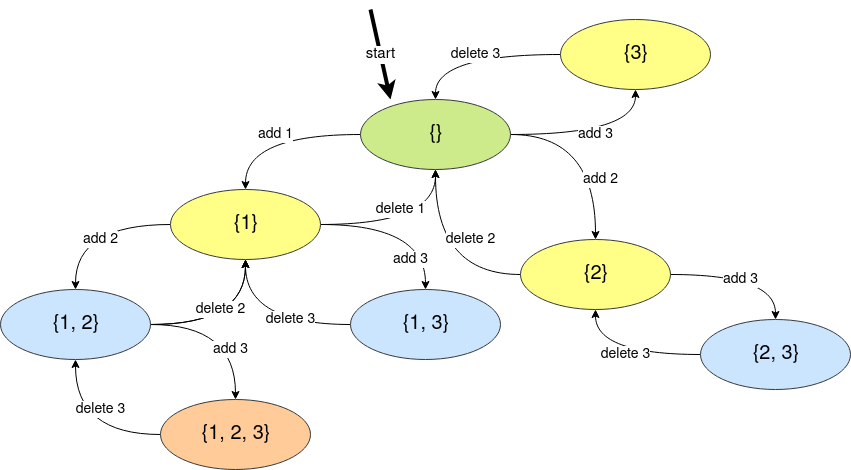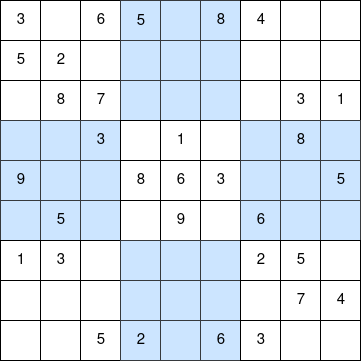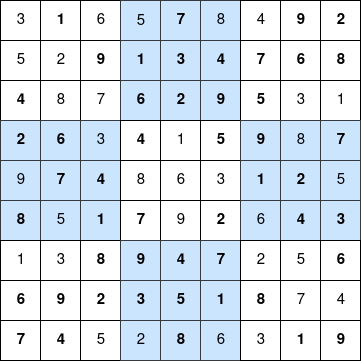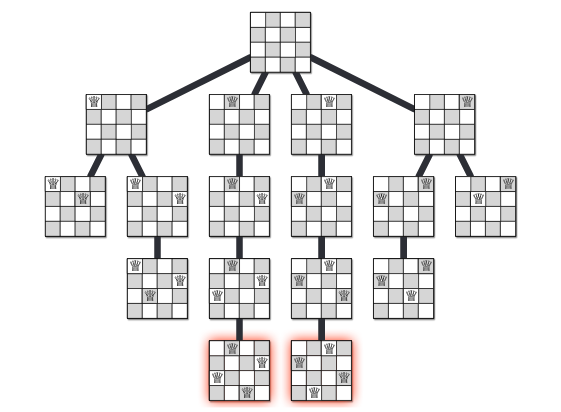Class 08: Complete Search V
01-29-2020
“Like the God of go”
The power set of a set is the set of all its subsets. For example:
\[A = \{1, 2, 3\}\] \[P(A) = \{\emptyset, \{1\}, \{2\}, \{3\}, \{1, 2\}, \{2, 3\}, \{1, 3\}, \{1, 2, 3\} \}\]
Here \(P(A)\) represents the power set of the set \(A\). Moreover, we have that \(|P(A)| = 2^{|A|}\).
Extra: In some books, \(P(A)\) is written as \(2^{A}\) (e.g Motousek - Invitation to Discrete Mathematics).
We already know how to generate the power set of \(A = \{1, 2, 3, \dots, n\}\) using bitmasks.
Code
#include <bits/stdc++.h>
using namespace std;
void print (const vector <int>& arr) {
cout << "{";
bool first = true;
for (int elem: arr) {
if (!first) {
cout << ", ";
}
cout << elem;
first = false;
}
cout << "}\n";
}
int main () {
int n = 3;
for (int mask = 0; mask < (1 << n); mask++) {
vector <int> subset;
for (int bit = 0; bit < n; bit++) {
if ((mask >> bit) & 1) {
subset.push_back(bit + 1);
}
}
print(subset);
}
return (0);
}But, we can also generate it using recursion, but before that, let’s review about passing arguments to a function in C++.
#include <bits/stdc++.h>
using namespace std;
// Here is passed a reference to 'arr' in O(1)
// You CAN read from 'arr', but you CAN NOT modify it
void f1 (const vector <int>& arr) {
}
// Here is passed a reference to 'arr' in O(1)
// You CAN read from 'arr' and you CAN modify it
void f2 (vector <int>& arr) {
}
// Here is passed a copy of 'arr' in O(n)
// You CAN read from 'arr' and you CAN modify it
// BUT, you are modifying a copy of 'arr', not the 'arr' of 'main'
void f3 (vector <int> arr) {
}
int main () {
int n = 10000;
vector <int> arr(n);
for (int i = 0; i < n; i++) {
arr[i] = i;
}
f1(arr);
f2(arr);
f3(arr);
return (0);
}If we want to generate the power set of \(A = \{1, 2, 3\}\), we can make a function that follows these states:

That is, if we are in the state \((a_1, a_2, \dots a_x) \mid a_1 < a_2 < \dots < a_x\), then we can go to \((a_1, a_2, \dots, a_x, a_y) \mid a_x < a_y \leq n\).
And we can implement it using recursion.
Code
#include <bits/stdc++.h>
using namespace std;
void print (const vector <int>& arr) {
cout << "{";
bool first = true;
for (int elem: arr) {
if (!first) {
cout << ", ";
}
cout << elem;
first = false;
}
cout << "}\n";
}
void backtrack (vector <int>& arr, const int n) {
print(arr);
int ax = 0;
if (!arr.empty()) {
ax = arr.back();
}
for (int ay = ax + 1; ay <= n; ay++) {
// add ay
arr.push_back(ay);
backtrack(arr, n);
// delete ay
arr.pop_back();
}
}
int main () {
int n = 3;
vector <int> subset;
backtrack(subset, n);
}But, in competitive programming, we usually try to have as few parameters in our functions as possible. Then, we realize that we can implement it in this way (why?).
Code
#include <bits/stdc++.h>
using namespace std;
void print (const vector <int>& arr) {
cout << "{";
bool first = true;
for (int elem: arr) {
if (!first) {
cout << ", ";
}
cout << elem;
first = false;
}
cout << "}\n";
}
// global variables
vector <int> subset;
int n;
void backtrack () {
print(subset);
int ax = 0;
if (!subset.empty()) {
ax = subset.back();
}
for (int ay = ax + 1; ay <= n; ay++) {
// add ay
subset.push_back(ay);
backtrack();
// delete ay
subset.pop_back();
}
}
int main () {
n = 3;
backtrack();
}Here we have implemented a program to find the power set of \(\{1, 2, 3, \dots, n\}\) in \(O(n 2 ^ n)\). This is a solution using what is known as backtracking. In general, a backtracking solution has this form:
let state be a global variable
T backtrack (some parameters):
if (state is a terminal state):
Do something with 'state' and return something
for (state' reachable from state):
# do something
previous = state
state = state'
backtrack(some parameters')
# reverse changes
state = previousA terminal state is a state in which we can not go to other states (or it is not convenient to follow searching).
Problem: You have a knapsack of capacity \(W\) (i.e you can put at most \(W\) kg in this knapsack). Moreover, you have \(n\) items. Each item is describe as a pair \((val_i, w_i)\), where \(val_i\) is the cost of the item and \(w_i\) the weight of it. Find the maximum value you can store in this knapsack using the least possible weight.
\[1 \leq n \leq 16\]
Solution:
Each item can be taken or not, then we can search over all the possibilites (power set) using bitmasks or backtracking.
Code
#include <bits/stdc++.h>
using namespace std;
int n;
int W;
vector <int> val;
vector <int> w;
vector <int> take;
int max_sum_val = 0;
int min_sum_w = 0;
vector <int> ans_items_taken;
void backtrack (int last_taken, int sum_val, int sum_w) {
if (sum_w <= W and (sum_val > max_sum_val or
(sum_val == max_sum_val and sum_w < min_sum_w))) {
max_sum_val = sum_val;
min_sum_w = sum_w;
ans_items_taken = take;
}
for (int i = last_taken + 1; i < n; i++) {
take.push_back(i);
backtrack(i, sum_val + val[i], sum_w + w[i]);
take.pop_back();
}
}
int main () {
n = 3;
W = 10;
// item 1
val.push_back(10);
w.push_back(10);
// item 2
val.push_back(1);
w.push_back(8);
// item 3
val.push_back(13);
w.push_back(2);
backtrack(-1, 0, 0);
cout << "Take items";
for (int item: ans_items_taken) {
cout << ' ' << item + 1;
}
cout << '\n';
return (0);
}The problem of generating all the permutations can also be easily computed using backtracking in \(O(n n!)\)
Code
#include <bits/stdc++.h>
using namespace std;
int n;
vector <bool> used;
vector <int> permutation;
void print (const vector <int>& p) {
for (int elem: p) {
cout << elem << ' ';
}
cout << '\n';
}
void backtrack () {
if (permutation.size() == n) {
print(permutation);
return;
}
for (int p_i = 1; p_i <= n; p_i++) {
if (!used[p_i]) {
used[p_i] = true;
permutation.push_back(p_i);
backtrack();
used[p_i] = false;
permutation.pop_back();
}
}
}
int main () {
n = 3;
used.resize(n + 1, false);
backtrack();
return (0);
}Here we are following these states:

This image represents what is called the recursion tree. It show us how the function do the transitions.
Moreover, notice that we do not need to do something like this:
.
.
.
for (int p_i = 1; p_i <= n; p_i++) {
if (!used[p_i]) {
vector <bool> used_previous = used;
vector <int> permutation_previous = permutation;
used[p_i] = true;
permutation.push_back(p_i);
backtrack();
used = used_previous;
permutation = permutation_previous;
}
}
.
.
.Because it will be heavier that the first solution and we know that:
- If previous of calling the recursion we ADD an element TO THE END of the vector, then after the recursion we must DELETE THE LAST element of the vector.
- If previous of calling the recursion we SET TO TRUE an element, then after the recursion we must SET TO FALSE that element.
- If previous of calling the recursion we ADD something, then after the recursion we must SUBTRACT something.
- Following this logic, If previous of calling the recursion we DO ONE OPERATION, then after the recursion we must REVERSE that operation. If the operation is complicated we can just save a copy of the previous state, else we can try to reverse the operations.
From all this one notice that if you are in your recursion in some state and you go to state', then after returning of traversing the recursion tree of state' you expect to have some variables in the condition they were before traversing the recursion tree of state'. Understanding this idea is the key to implement backtracking solutions.
With backtracking it is easy to generate all possible movements in a game and choose the best movement.
Problem:

Complete the above sudoku such that each number from 1 to 9 is found just once in each row, column and quadrant.
Solution: We can just search all possible solutions using bactracking.
Code
#include <bits/stdc++.h>
using namespace std;
vector <vector <int>> sudoku;
vector <vector <int>> sudoku_solved;
vector <vector <pair <int, int>>> quadrant;
int n;
int N;
bool found;
bool validInRow (int r, int d) {
for (int c = 0; c < N; c++) {
if (sudoku[r][c] == d) return false;
}
return true;
}
bool validInCol (int c, int d) {
for (int r = 0; r < N; r++) {
if (sudoku[r][c] == d) return false;
}
return true;
}
bool validInQuadrant (int q, int d) {
for (pair <int, int> pos: quadrant[q]) {
int r = pos.first;
int c = pos.second;
if (sudoku[r][c] == d) return false;
}
return true;
}
// run this function for every 0 <= r < N and 0 <= c < N and you will get
// what this function does
int getQuadrant (int r, int c) {
return (r / n) * n + (c / n);
}
void backtrack (int r, int c) {
if (r == N) {
found = true;
sudoku_solved = sudoku;
return;
}
if (found) {
return;
}
int nc = (c + 1 == N) ? 0 : c + 1; // new column
int nr = (c + 1 == N) ? r + 1 : r; // new row
if (sudoku[r][c] != 0) {
backtrack(nr, nc);
return;
}
for (int d = 1; d <= 9; d++) {
int quadrant = getQuadrant(r, c);
if (validInRow(r, d) and
validInCol(c, d) and
validInQuadrant(getQuadrant(r, c), d)) {
sudoku[r][c] = d;
backtrack(nr, nc);
sudoku[r][c] = 0;
}
}
}
void precomputation () {
found = false;
N = sudoku.size();
n = 1;
while ((n + 1) * (n + 1) <= N) n++;
// n = sqrt(N)
quadrant.resize(N);
for (int r = 0; r < N; r++) {
for (int c = 0; c < N; c++) {
quadrant[getQuadrant(r, c)].push_back({r, c});
}
}
}
void print (const vector <vector <int>>& sudoku) {
for (auto row: sudoku) {
for (int elem: row) {
cout << elem << ' ';
}
cout << '\n';
}
}
int main () {
sudoku = {
{3, 0, 6, 5, 0, 8, 4, 0, 0},
{5, 2, 0, 0, 0, 0, 0, 0, 0},
{0, 8, 7, 0, 0, 0, 0, 3, 1},
{0, 0, 3, 0, 1, 0, 0, 8, 0},
{9, 0, 0, 8, 6, 3, 0, 0, 5},
{0, 5, 0, 0, 9, 0, 6, 0, 0},
{1, 3, 0, 0, 0, 0, 2, 5, 0},
{0, 0, 0, 0, 0, 0, 0, 7, 4},
{0, 0, 5, 2, 0, 6, 3, 0, 0}
};
precomputation();
backtrack(0, 0);
print(sudoku_solved);
return (0);
}With this code we get this solution:

Problem: Given a chess board having \(N \times N\) cells, you need to place \(N\) queens on the board in such a way that no queen attacks any other queen.
\[1 \leq N \leq 10\]
Remember: A queen can attack in a complete row, column or diagonal.
Solution: We could try to place N queen in the \(N \times N\) cells. In this way we may get \(\binom{N \times N}{N}\) states to check. But for \(N = 8\) we have that \(\binom{N \times N}{N} \approx 8B\), so we need a better approach.
We know that each queen should be in different columns (else they will be attacking each other). So we can generate these \(N^N\) possible configurations and check if the conditions holds, but this solution may not be enough.
We know that each queen should be in different rows and columns. Then, the rows of the queens of a valid configuration are a permutation. The same holds for the columns. Thereby, we have \(N!\) possible configurations to check. We can implement this idea using backtracking in this way:
Code
#include <bits/stdc++.h>
using namespace std;
int n;
vector <pair <int, int>> queen;
vector <pair <int, int>> solution;
bool valid (int r, int c) {
for (auto pp: queen) {
// if same row or same column or same diagonal
if ((pp.first == r) or
(pp.second == c) or
(abs(r - pp.first) == abs(c - pp.second))) {
return false;
}
}
return true;
}
void backtrack (int r) {
if (r == n) {
solution = queen;
return;
}
if (!solution.empty()) {
return;
}
for (int c = 0; c < n; c++) {
if (valid(r, c)) {
queen.push_back({r, c});
backtrack(r + 1);
queen.pop_back();
}
}
}
int main () {
cin >> n;
backtrack(0);
if (solution.empty()) {
cout << "NO\n";
return (0);
}
vector <vector <int>> board(n, vector <int> (n, 0));
for (auto pp: solution) {
board[pp.first][pp.second] = 1;
}
cout << "YES\n";
for (int r = 0; r < n; r++) {
for (int c = 0; c < n; c++) {
cout << board[r][c] << " \n"[c == n - 1];
}
}
return (0);
}For \(N = 4\) the recursion tree of our solution is like this:

Image taken from Jeff Erickson - Algorithms - Chapter 2: Backtracking.
The complexity of the above solution comes from the equation:
\[T_n = n \cdot T_{n - 1} + O(n)\] \[\to T_n = O(n!)\]
Then, our solution has complexity \(O(n!)\).
Recommended readings:
- HackerEarth - Recursion and Backtracking
- Competitive Programming 3, section 3.2.2, 8.2.1 and 8.2.2.
- GeekForGeeks - Backtracking Algorithms
You can find the contest here.
A: CD
CD
Each element can be taken or not, then a backtracking solution will give us the answer and keet the initial order of the items.
Code
#include <bits/stdc++.h>
using namespace std;
int main () {
int n;
while (cin >> n) {
int m;
cin >> m;
vector <int> arr(m);
for (int& elem: arr) cin >> elem;
vector <int> take;
vector <int> ans;
int sum = 0;
int best_sum = 0;
function <void(int)> backtrack = [&] (int pos) -> void {
if (sum > best_sum or (sum == best_sum and ans.size() < take.size())) {
best_sum = sum;
ans = take;
}
if (pos == m) return;
// do not take it
backtrack(pos + 1);
if (sum + arr[pos] > n) return;
// take it
take.push_back(arr[pos]);
sum += arr[pos];
backtrack(pos + 1);
take.pop_back();
sum -= arr[pos];
};
backtrack(0);
for (int elem: ans) cout << elem << ' ';
cout << "sum:" << best_sum << '\n';
}
return (0);
}B: Hanoi Tower Troubles Again!
Hanoi Tower Troubles Again!
There is a greedy approach, you can put a ball in the first pile where you can do it.
Code
#include <bits/stdc++.h>
using namespace std;
int main () {
const int N = 1e5;
vector <bool> is_sq(N, false);
for (int i = 0; i * i < N; i++) is_sq[i * i] = true;
int tc;
cin >> tc;
while (tc--) {
int n;
cin >> n;
vector <vector <int>> pile(n);
int ans = 0;
int cur = 0;
function <void(int)> rec = [&] (int num) -> void {
ans = max(ans, cur);
for (int i = 0; i < n; i++) {
if (pile[i].empty() or is_sq[pile[i].back() + num]) {
cur += 1;
pile[i].push_back(num);
rec(num + 1);
break;
}
}
};
rec(1);
cout << ans << '\n';
}
return (0);
}C: Marcus
Marcus
Identify the initial point and then search on the grid using backtracking.
Code
#include <bits/stdc++.h>
using namespace std;
int main () {
const vector <int> dr = {-1, 0, 0};
const vector <int> dc = {0, -1, 1};
const vector <string> option = {"forth", "left", "right"};
const string word = "IEHOVA#";
int tc;
cin >> tc;
while (tc--) {
int n, m;
cin >> n >> m;
vector <string> ans;
vector <string> take;
vector <string> grid(n);
for (int i = 0; i < n; i++) cin >> grid[i];
function <void(int,int)> backtrack = [&] (int r, int c) -> void {
if (take.size() == 7) {
ans = take;
return;
}
for (int d = 0; d < 3; d++) {
if (!ans.empty()) return;
int nr = r + dr[d];
int nc = c + dc[d];
if (not (0 <= min(nr, nc) and nr < n and nc < m)) continue;
if (grid[nr][nc] != word[take.size()]) continue;
take.push_back(option[d]);
backtrack(nr, nc);
take.pop_back();
}
};
for (int r = 0; r < n; r++) {
for (int c = 0; c < m; c++) {
if (grid[r][c] == '@') {
backtrack(r, c);
}
}
}
for (int i = 0; i < 7; i++) {
cout << ans[i] << " \n"[i == 6];
}
}
return (0);
}D: Back to the 8-Queens
Back to the 8-Queens
There are just 92 valid configurations, we can generate all of them using backtracking and do a simple linear search to get the answer for each query.
Code
#include <bits/stdc++.h>
using namespace std;
const int N = 8;
vector <pair <int, int>> queen;
vector <vector <pair <int, int>>> solution;
bool valid (int r, int c) {
for (auto pp: queen) {
// if same row or same column or same diagonal
if ((pp.first == r) or
(pp.second == c) or
(abs(r - pp.first) == abs(c - pp.second))) {
return false;
}
}
return true;
}
void backtrack (int c) {
if (c == N + 1) {
solution.push_back(queen);
return;
}
for (int r = 1; r <= N; r++) {
if (valid(r, c)) {
queen.push_back({r, c});
backtrack(c + 1);
queen.pop_back();
}
}
}
int main () {
backtrack(1);
vector <int> row(N);
int tc = 0;
while (cin >> row[0]) {
for (int i = 1; i < N; i++) cin >> row[i];
int ans = INT_MAX;
for (auto sol: solution) {
int need = 0;
for (int i = 0; i < N; i++) {
need += (row[i] != sol[i].first);
}
ans = min(ans, need);
}
cout << "Case " << ++tc << ": " << ans << '\n';
}
return (0);
}E: Boggle Blitz
Boggle Blitz
Just use backtracking to do a complete search.
Code
#include <bits/stdc++.h>
using namespace std;
int main () {
int tc;
cin >> tc;
for (int t = 0; t < tc; t++) {
if (t) cout << '\n';
int n;
cin >> n;
vector <string> grid(n);
for (int i = 0; i < n; i++) cin >> grid[i];
vector <string> ans;
string word = "";
function <void(int,int,char)> backtrack = [&] (int r, int c, char last) -> void {
if (3 <= word.size()) {
ans.push_back(word);
}
for (int dr = -1; dr <= 1; dr++) {
for (int dc = -1; dc <= 1; dc++) {
if (dr == 0 and dc == 0) continue;
int nr = r + dr;
int nc = c + dc;
if (not (0 <= min(nr, nc) and max(nr, nc) < n)) continue;
if (grid[nr][nc] <= last) continue;
word += grid[nr][nc];
backtrack(nr, nc, grid[nr][nc]);
word.pop_back();
}
}
};
for (int r = 0; r < n; r++) {
for (int c = 0; c < n; c++) {
word += grid[r][c];
backtrack(r, c, grid[r][c]);
word.pop_back();
}
}
sort(begin(ans), end(ans), [&] (const string& x, const string& y) {
if (x.size() != y.size()) return x.size() < y.size();
return x < y;
});
// delete duplicates
ans.erase(unique(begin(ans), end(ans)), end(ans));
for (auto& word: ans) cout << word << '\n';
}
return (0);
}